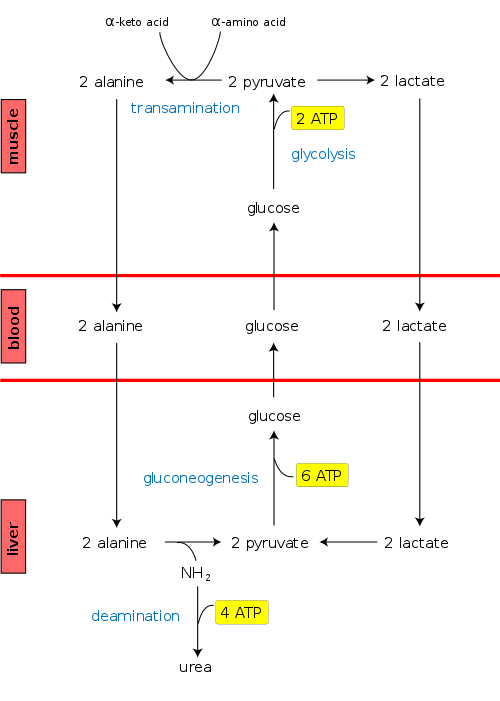Cahill cycle

The Cahill cycle, also known as the alanine cycle or glucose-alanine cycle, is the series of reactions in which amino groups and carbons from muscle are transported to the liver.[1] It is quite similar to the Cori cycle in the cycling of nutrients between skeletal muscle and the liver. When muscles degrade amino acids for energy needs, the resulting nitrogen is transaminated to pyruvate to form alanine. This is performed by the enzyme alanine transaminase (ALT), which converts L-glutamate and pyruvate into α-ketoglutarate and L-alanine.[2] The resulting L-alanine is shuttled to the liver where the nitrogen enters the urea cycle and the pyruvate is used to make glucose.[3]
The Cahill cycle is less productive than the Cori cycle, which uses lactate, since a byproduct of energy production from alanine is production of urea.[4] Removal of the urea is energy-dependent, requiring four "high-energy" phosphate bonds (3 ATP hydrolyzed to 2 ADP and one AMP), thus the net ATP produced is less than that found in the Cori cycle. However, unlike in the Cori cycle, NADH is conserved because lactate is not formed. This allows for it to be oxidized via the electron transport chain.
The Cahill cycle requires the presence of alanine aminotransferase (alanine transaminase, ALT), which is restricted to tissues such as muscle, liver, and the intestine. Therefore, this pathway is used instead of the Cori cycle only when an aminotransferase is present, when there is a need to transfer ammonia to the liver and when the body is in a state of catabolism (muscle breakdown).
The alanine cycle also serves other purposes:
- Recycling of carbon skeletons in muscle and liver.
- Participation in the transport of ammonium to the liver and conversion into urea.
This cycle is an important part of mammal physiology, but although fish use alanine as a nitrogen carrier, the cycle is unlikely to take place in fish, due to their slower glucose turnover rate and lower release of alanine from exercising muscle tissue.[5] Its presence and physiological significance in non-mammalian land vertebrates is unclear.[6]
References
- ↑ Naik, Pankaja (1 November 2011). Essentials of Biochemistry. JP Medical Ltd. p. 168. ISBN 9789350254912.
- ↑ Karmen A, Wroblewski F, Ladue JS (Jan 1955). "Transaminase activity in human blood". The Journal of Clinical Investigation. 34 (1): 126–31. doi:10.1172/JCI103055. PMC 438594. PMID 13221663.
- ↑ Kaplan Medical USMLE Step 1 Qbook. Kaplan Publishing. 2 September 2008. p. 172. ISBN 9781419553158.
As muscle proteins are catabolized, the amino acid skeletons are used as fuel in the muscle, while the amino groups are transaminated from pyruvate, forming alanine, which is then transported to the liver and kidney cortex to be used in gluconeogenesis (Cahill cycle).
- ↑ Cifuentes, Alejandro (5 February 2013). Foodomics: Advanced Mass Spectrometry in Modern Food Science and Nutrition. John Wiley & Sons. p. 335. ISBN 9781118537350.
Alanine plays an important role in the Cahill cycle or alanine-glucose cycle, and changes in alanine metabolite may indicate that this cycle could be modified (Yan et al., 2009).
- ↑ Fish Physiology: Nitrogen Excretion. Academic Press. 2001-09-07. p. 23. ISBN 9780080497518.
- ↑ Walsh, Patrick J.; Wright, Patricia A. (1995-08-31). Nitrogen Metabolism and Excretion. CRC Press. ISBN 9780849384110.
External links
- Diagram at Colorado.edu
- at indstate.edu